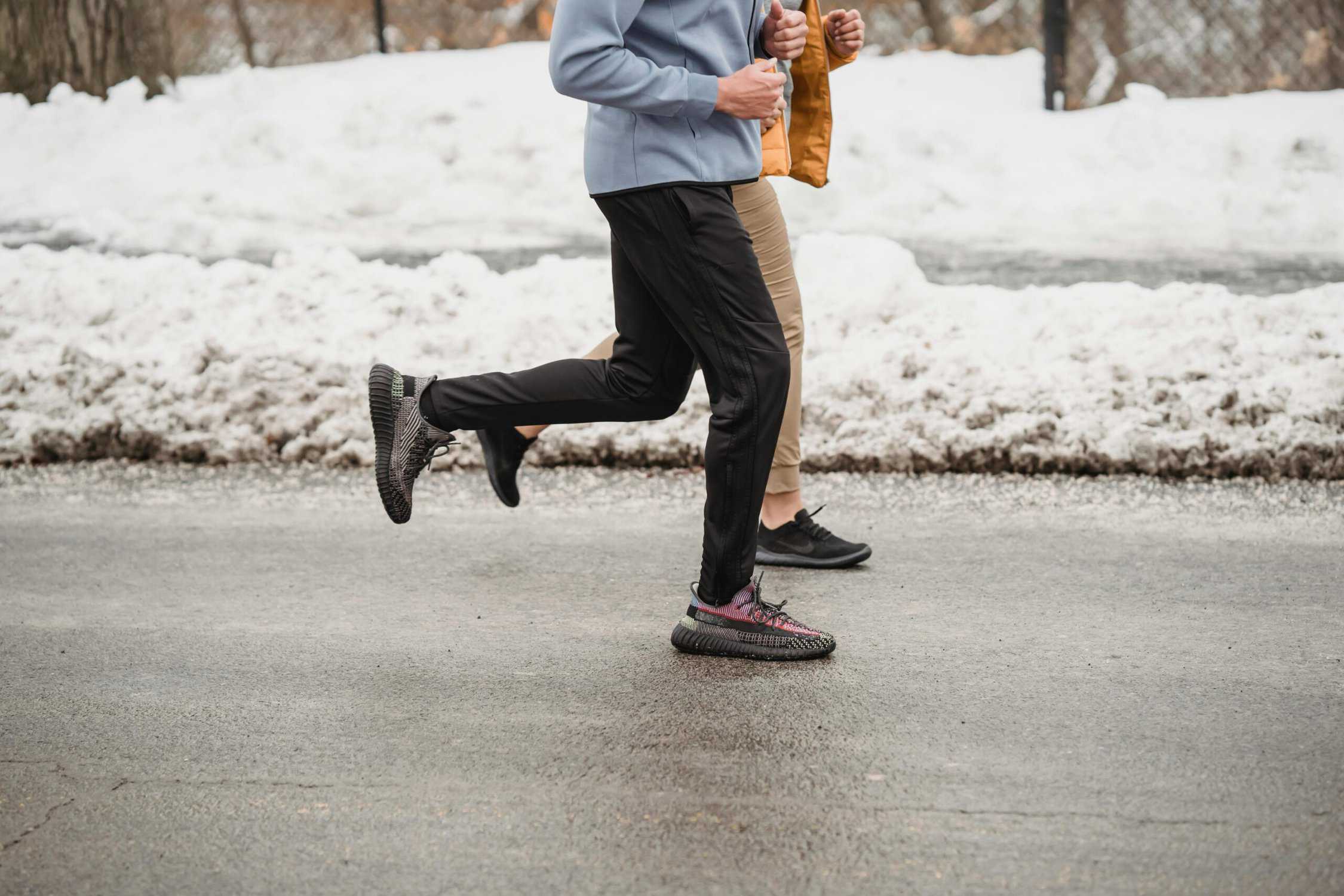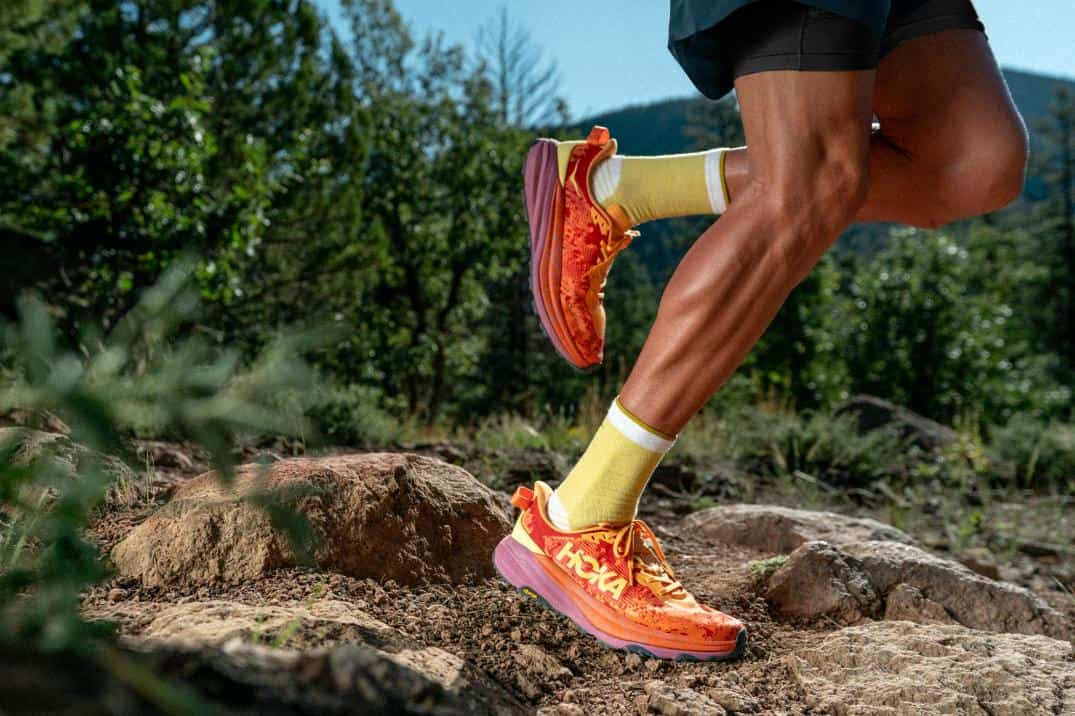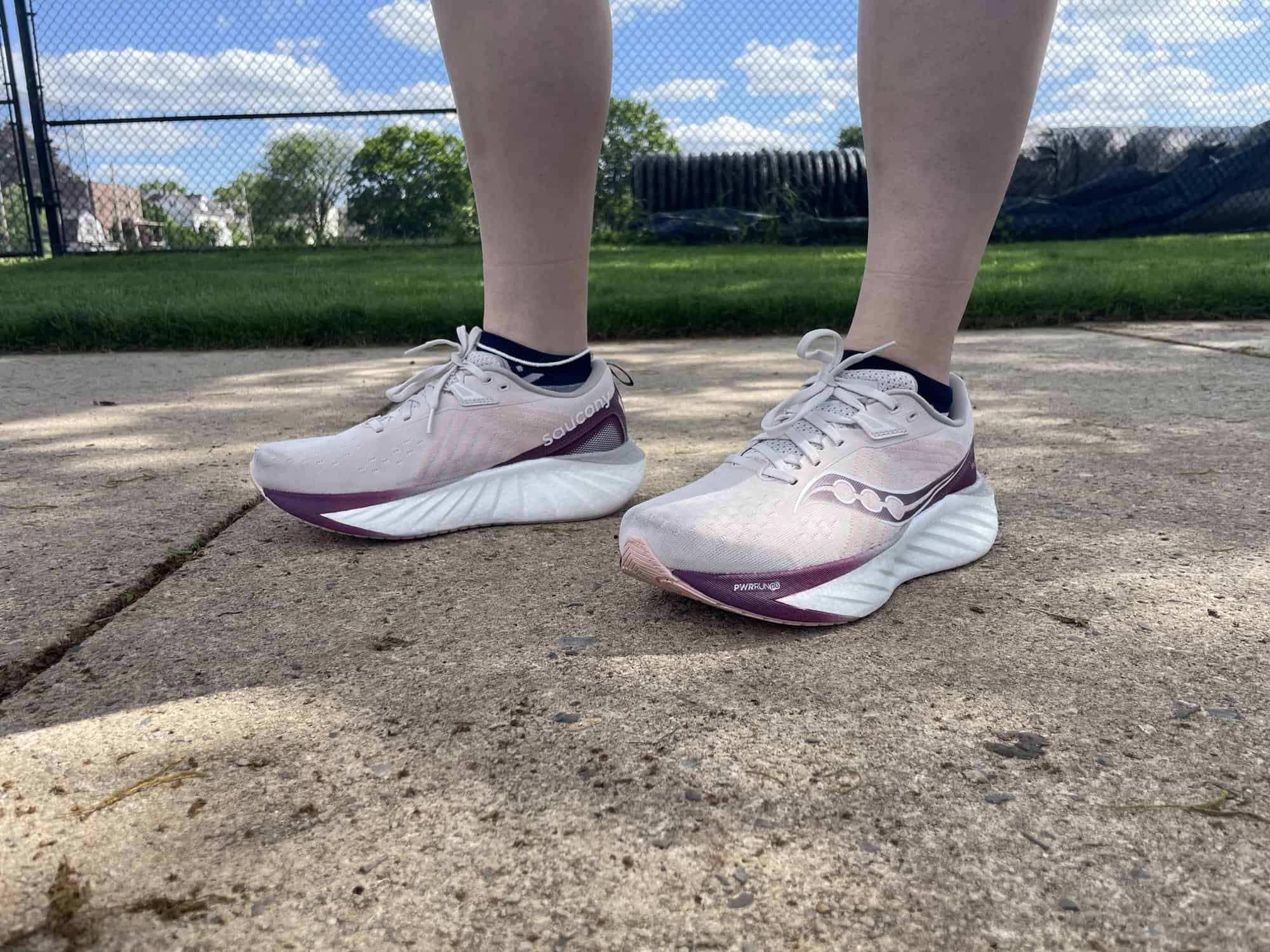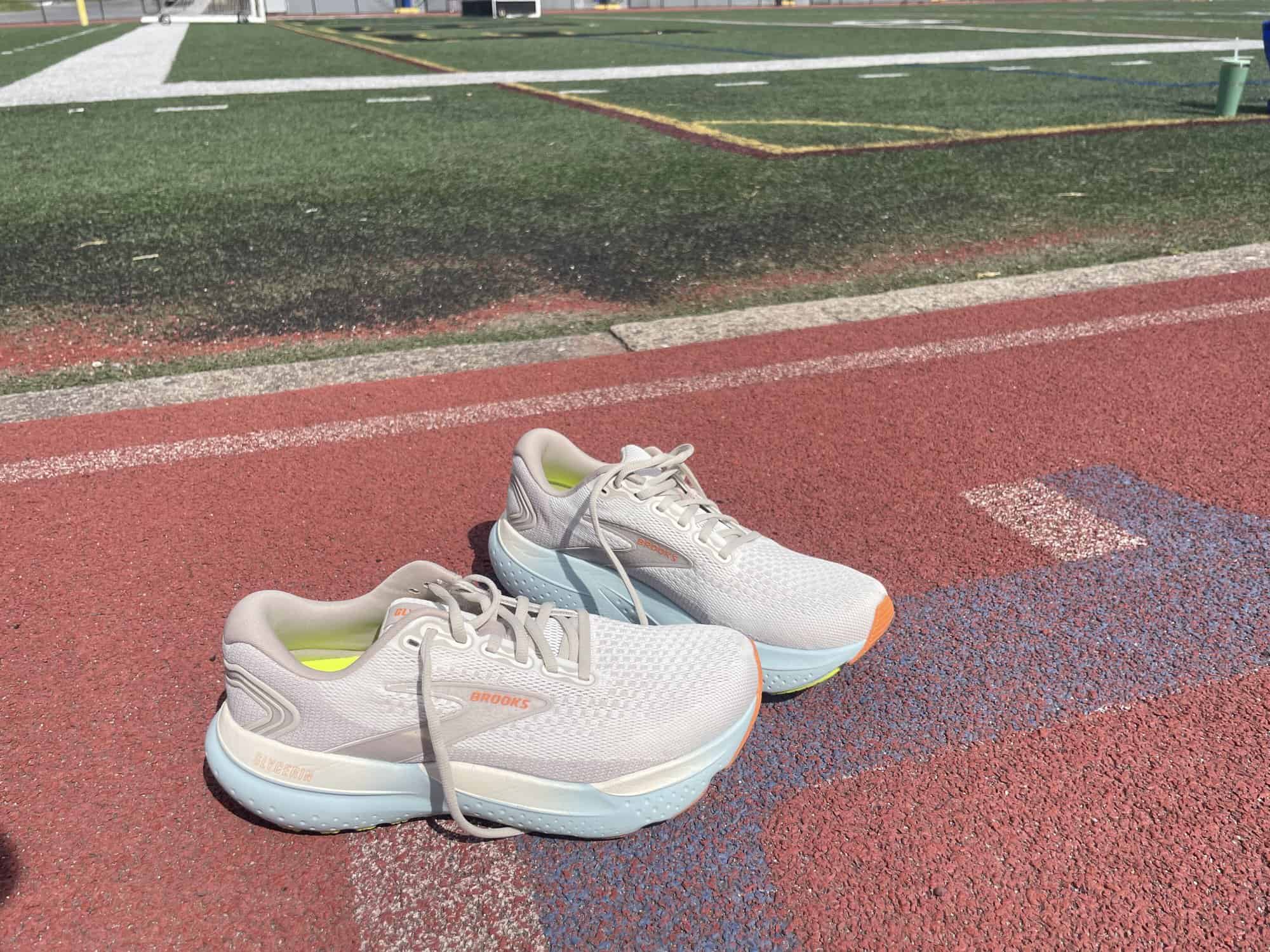There are a lot of factors that go into picking the right running shoe, but one key consideration is whether you want — or need — a stability shoe. “[Stability] shoes are designed with extra support and cushioning to help control overpronation and minimize the strain on your feet during long runs,” says personal trainer Sean Klein, CPT, founder of the Programme workout app. The art of picking the best stability running shoes for you this year will come down to how much, or little, structure you really need.
When your foot rolls outward as it makes contact with the ground, known as overpronation, this causes the arches of your feet to flatten more, putting a strain on your muscles, tendons, and ligaments. While there is debate on how necessary they are, the best stability shoes provide more arch support which many overpronating runners feel leads to a more comfortable and injury-free run.
The best stability running shoes are pretty tech advanced these days, but model-to-model still range in fit, design, cushion level, and support systems. As a long-time runner and gear tester myself, I’ve tested a lot of running shoes over the years. Combining my own experience testing running shoes and what other reviewers have to say about the leading options, we’ve determined the seven best stability running shoes of 2024.
Plus, at the end, we have expert advice on how to choose the right one for you.
Our Top Picks for the Best Stability Running Shoes
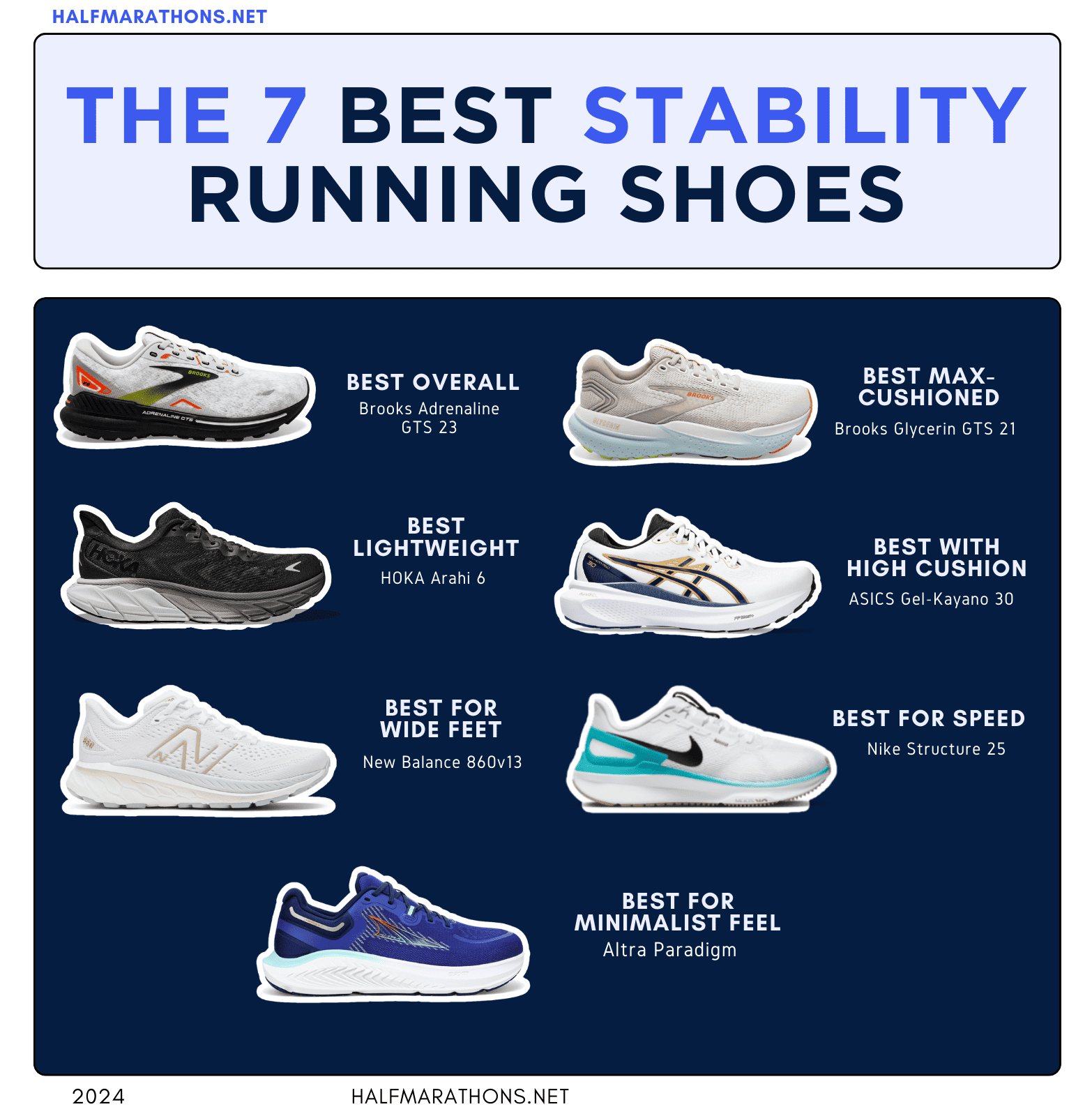
- Best Overall: Brooks Adrenaline GTS 23
- Best Overall with Max Cushion: Brooks Glycerin GTS 21
- Best Lightweight: Hoka Arahi 6
- Best High Cushion: Asics Gel-Kayano 30
- Best for Wide Feet: New Balance 860v13
- Best for Speedwork: Nike Structure 25
- Best Minimalist Feel: Altra Paradigm
Best Stability Running Shoe Overall: Brooks Adrenaline GTS 23
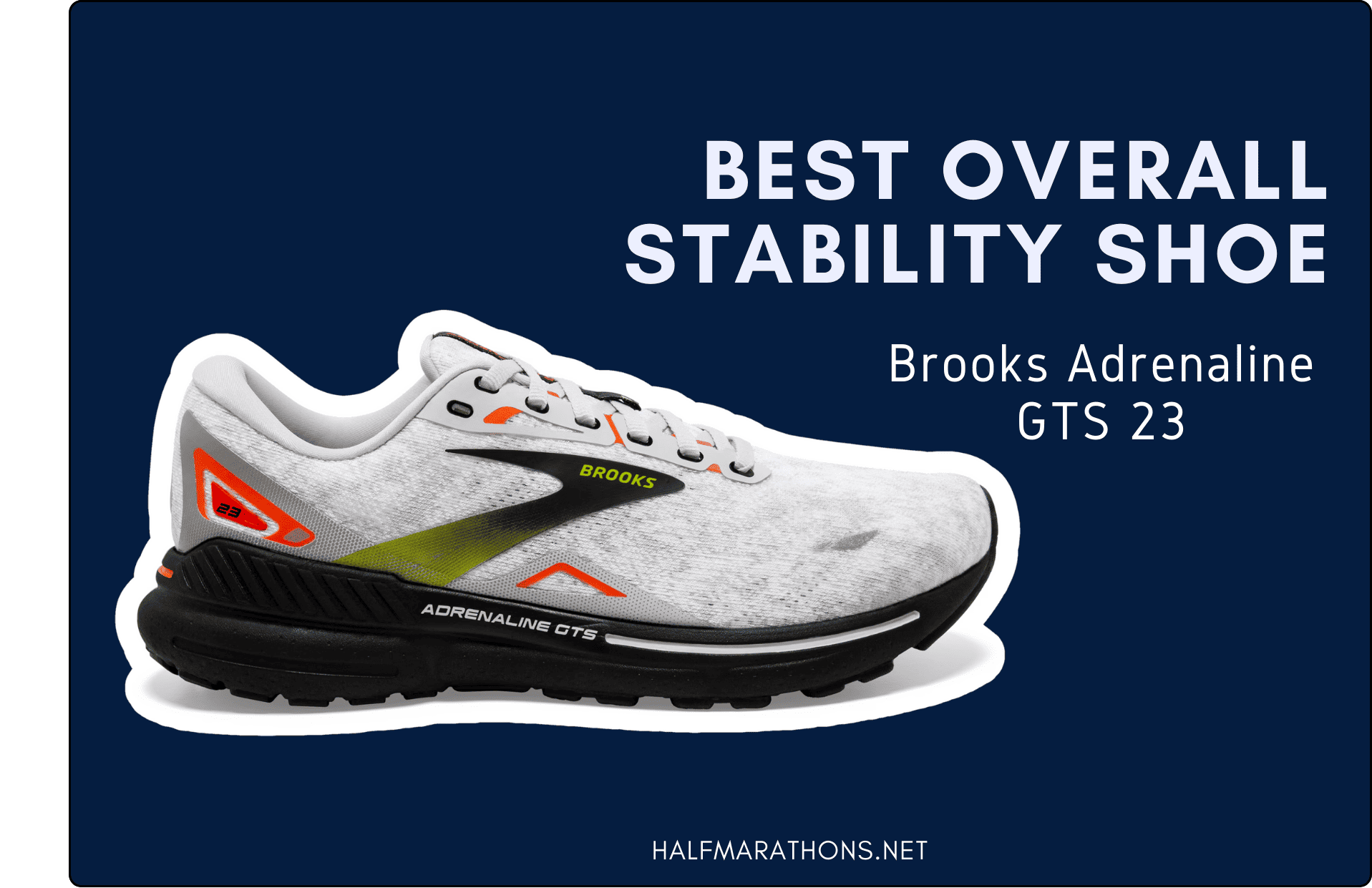
Specs:
- Weight: 10.1 oz
- Drop: 12 mm
- Price: $140
- Widths: Narrow, regular, wide, X-wide
One of the best-selling running shoes for decades, the Brooks Adrenaline is a mid-cushion model with just enough to be comfortable for long distances while remaining light and snappy enough for speedwork.
Brooks switched its midsole design from a rollbar system to guide rails. They work like bumpers. They are better at gently pushing the foot back into place when it strays from a neutral motion.
This means that everyone from overpronators to supinators (and everyone in between) can benefit from this shoe. Because of the adaptive support system, it also works excellently for neutral runners who find their gait deteriorates late in a long run.
If you regularly have knee or joint pain, you may want to opt for a higher cushion model. Our recommendations are the Brooks Glycerin GTS 20 or Asics Gel-Kayano 30 below.
But the Adrenaline GTS 23’s universal appeal, paired with quality construction and reliability of most any shoe Brooks makes, is why we’ve named it the best stability running shoe for most runners.
Best Overall with Max Cushion: Brooks Glycerin GTS 21
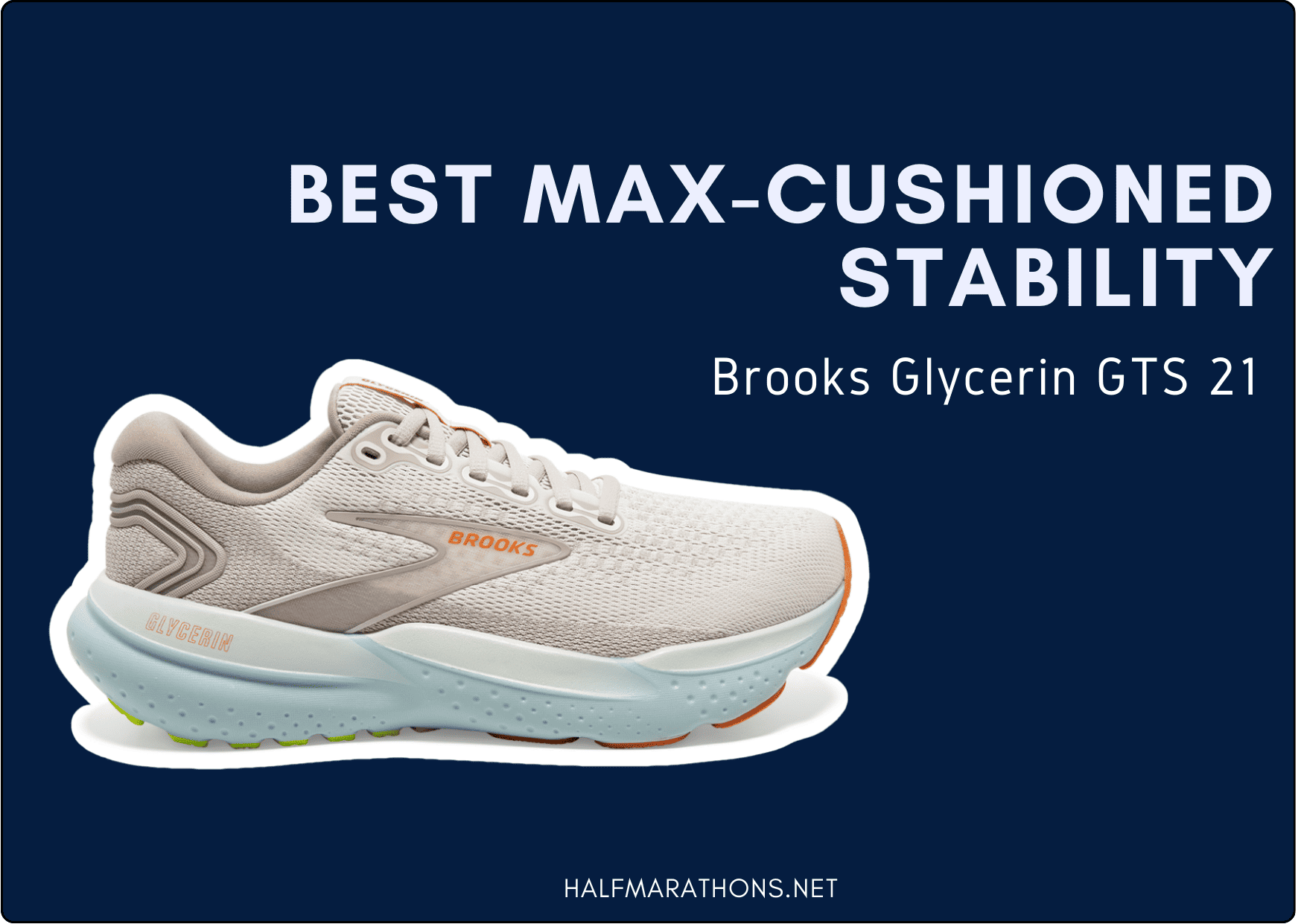
Specs:
- Weight: 9.1 oz
- Drop: 10 mm
- Price: $200
- Widths: Regular, wide
If you like the Adrenaline but need some more cushioning, the Glycerin GTS is a great option for you. With its plushy midsole, the Glycerin GTS 20 uses the same foam as the Adrenaline. The foam is the DNA Loft V 3 which is a nitrogen-infused foam that gives a soft but bouncy ride.
The Glycerin GTS 20 also has Brooks’ same guide rail support system as the Adrenaline. But it has a lower drop which promotes a natural footfall. Because of this lower drop, some people feel that this shoe provides a more natural running motion. Though all-in-all 2 mm doesn’t make a monumental difference, in my experience.
Though this shoe does offer adaptive support, some find that it is not quite as supportive as an option that uses a medial post. So, if you are in need of high levels of motion control, you may want to opt for something more aggressive.
The other major drawback to this shoe: It’s pretty pricey. But with the quality construction Brooks is known for and top-notch cushioning. The Glycerin GTS 20 is worth the higher price tag, in my opinion.
Best Lightweight: Hoka Arahi 6
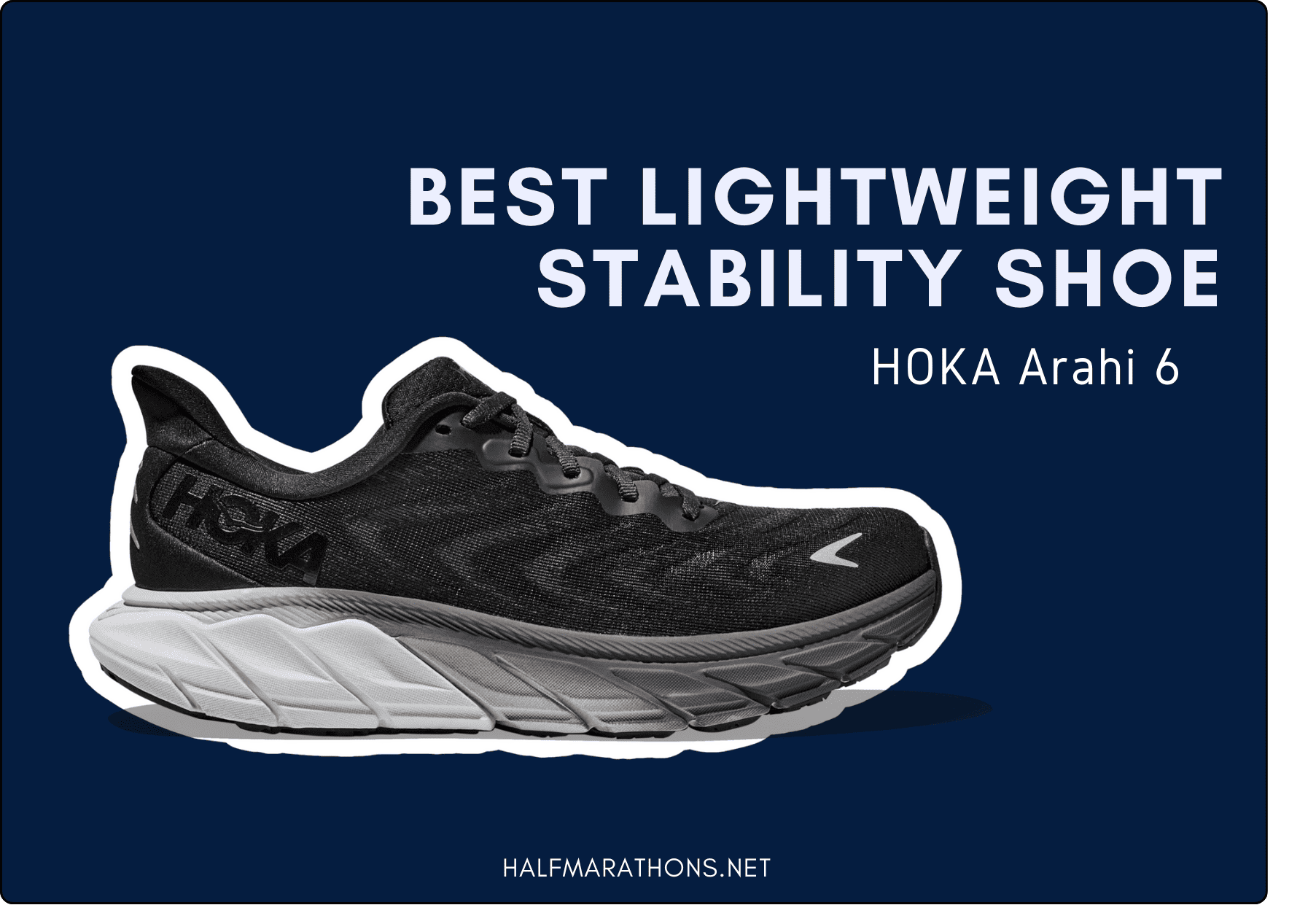
Specs:
- Weight: 7.6 oz
- Drop: 5 mm
- Price:
$140$112 - Widths: regular, wide
Hokas may look bulky at first glance. But, its signature thick midsoles are actually made from a super light and plush EVA foam. This gives most Hoka’s a cloud-like step without the brick-like feeling—and that’s certainly true for the Arahi.
The Arahi 6 uses Hoka’s J-frame technology which puts a denser foam around the heel and on the inside of the shoe. This provides stability and support without feeling stiff or heavy.
This shoe also uses an early-stage meta-rocker to help you roll through your foot, keeping your lower limbs feeling light. Its Meta-Rocker design also promotes a more efficient gait. This particularly helpful for heel strikers (though it works well for all types of runners).
One thing to note: Though lightweight, the Arahi 5 stability shoe can feel a bit clunky to some. So, they may not be your first choice for speed days.
Related: Best HOKAs for Half Marathon Runners
Best High Cushion: Asics Gel-Kayano 30
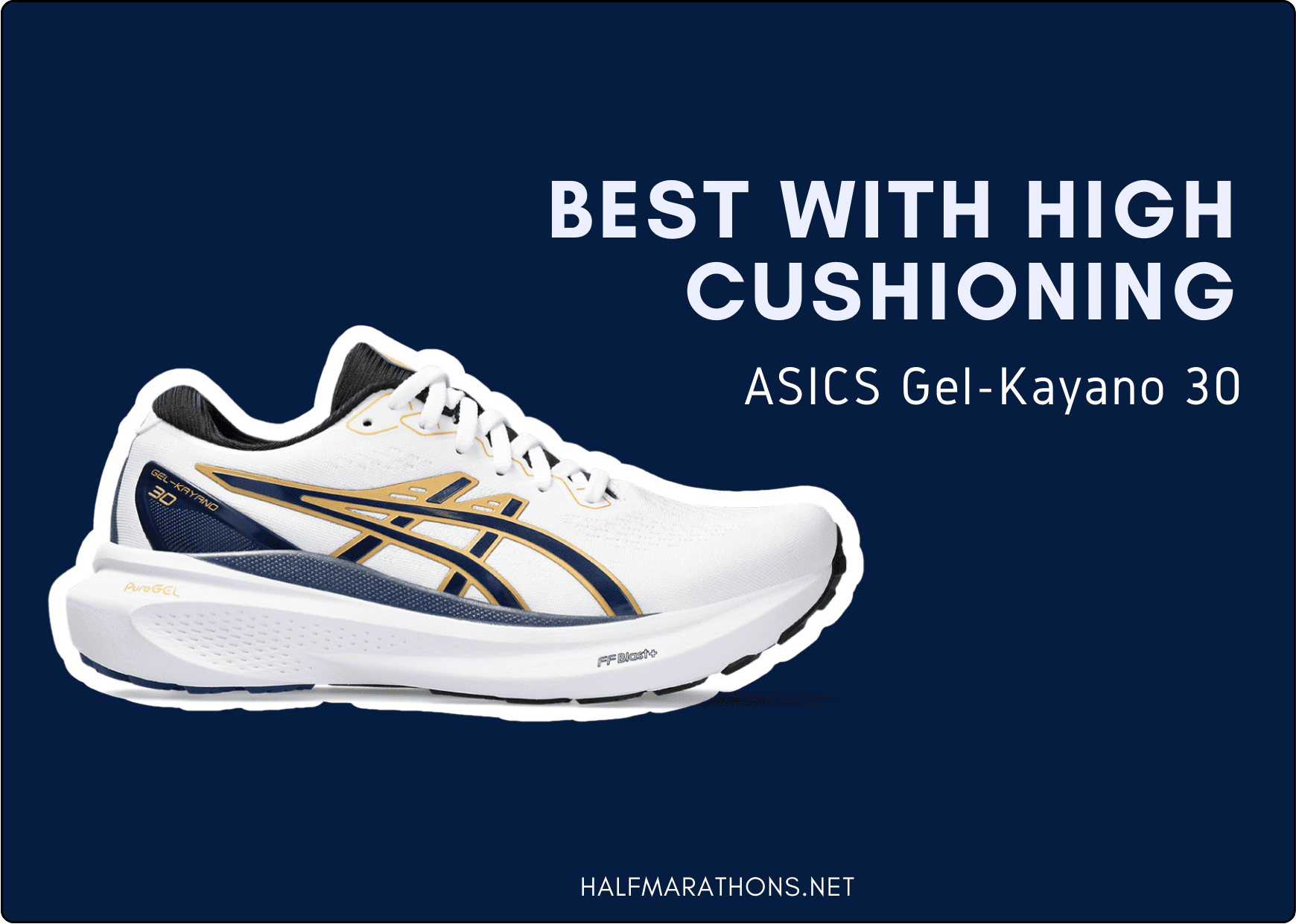
Specs:
- Weight: 9.3 oz
- Drop: 10 mm
- Price: $160
- Widths: Regular
The Asics Gel-Kayano has been a favorite among overpronators for decades. The latest model, the 30, lives up to the reputation: This shoe melds high support with high cushion for a super plush yet controlled ride. Together, this all helps to increase shock absorption, making running easier on the joints and feet. This newest model, the 30, has shaved weight from its predecessors thanks to the new FF Blast Plus Eco foam and an improved stability system.
Related: The Best ASICS for Half Marathoners
Instead of a stiff medial post, this shoe uses a 4D guidance system to provide adaptive stability. This means the more you overpronate, the more the shoe will push you back into a neutral position.
While it has less gel than it used to, this shoe still kept the signature gel-heel pad which gives it that extra-plush feel. This is especially beneficial for heel strikers.
One thing to note is that this shoe has quite a high stack. So, if you like to feel the ground underfoot, this may not be the best stability running shoe for you.
Best for Wide Feet: New Balance 860v13
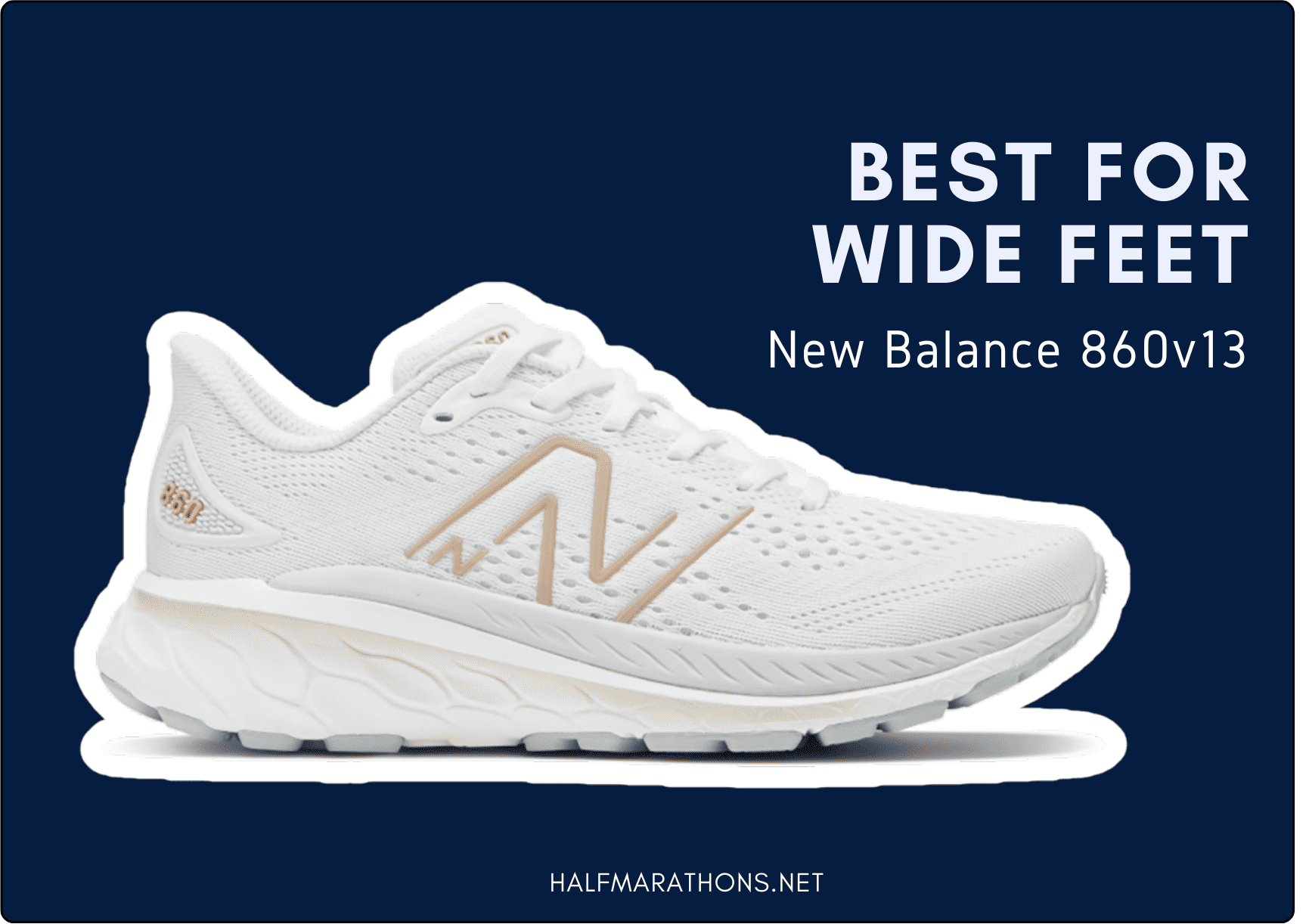
Specs:
- Weight: 8.6 oz
- Drop: 10 mm
- Price: $140
- Widths: Narrow, regular, wide, extra wide
If you have wide feet, you know it’s difficult to find a running shoe that doesn’t make your toes feel crammed. New Balance’s standard toe box runs a bit narrow. But, the brand makes a range of widths so you can score its much-loved shoe in a more personalized, wide or extra-wide fit.
It’s not just the size range that makes this shoe worth purchasing. The New Balance 860v13 is a great everyday training shoe with a responsive mid-cushion midsole and breathable mesh upper. This shoe is also more of the traditional stability shoe-design. Complete with a medial post great for severe overpronators or those that prefer a stiffer feel.
If you aren’t sure how much you overpronate though, this shoe may provide too much support. In that case, you may want to go for something more adaptive like the Brooks Adrenaline GTS 23.
Best for Speedwork: Nike Structure 25
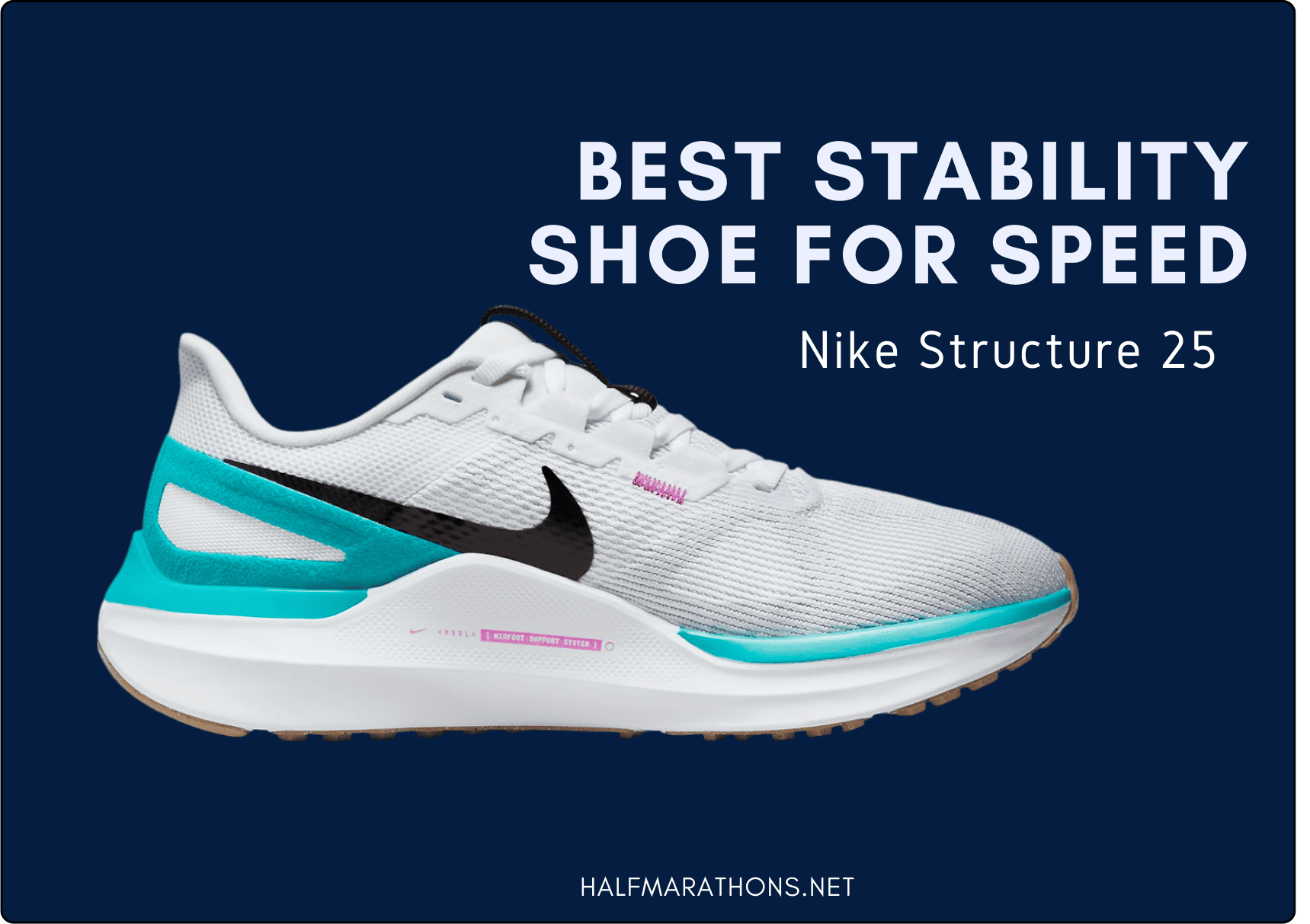
Specs:
- Weight: 9.3 oz
- Drop: 10 mm
- Price: $140
- Widths: Regular, wide
Despite being a pretty neutral runner myself, the Structure used to be one of my go-to running shoes. I was more than stoked when, after a few years off the market, Nike brought the Structure back to its running shoe lineup. The Structure 25 is slightly different from its predecessor back in 2019, but the great design has only improved.
After running in the Structure 25 myself, this shoe feels light and snappy thanks to the Zoom Air unit in the forefoot paired with a responsive foam. It uses dual-density foams to give you support where you need it, and a slightly-flared midsole design which increases stability, especially on uneven surfaces.
I did notice that this shoe runs particularly small, so you may want to size up a half to a full size for your regular fit. And as with all Nikes, this running shoe isn’t ideal for anyone with a wide toe box.
Check Price
Best Minimalist Feel: Altra Paradigm
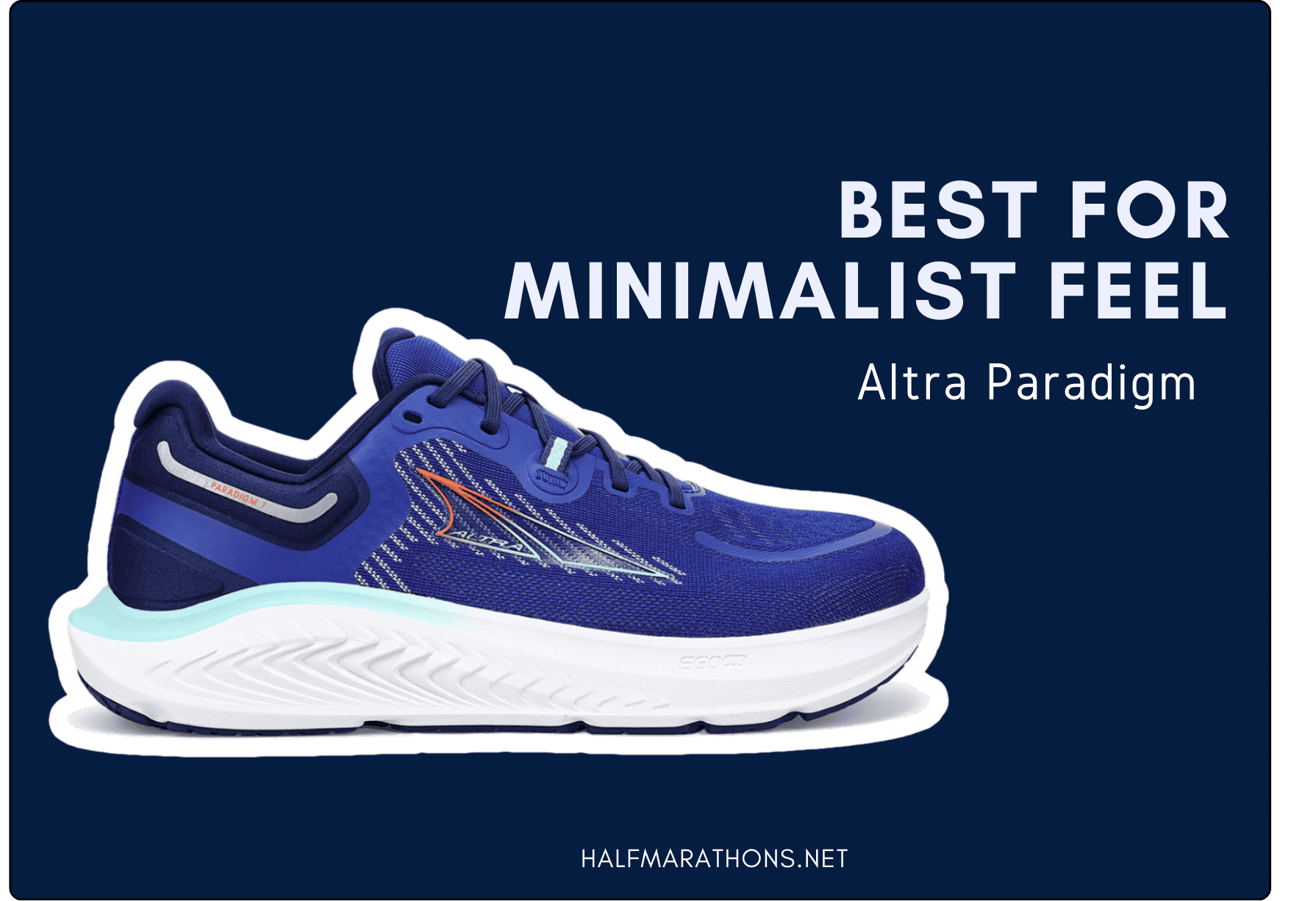
Specs:
- Weight: 8.2 oz
- Drop: 0 mm
- Price: $170
- Widths: Regular
Altra initially entered the running shoe market as a super-minimalist, zero-drop shoe. But after years of dominating this category, the brand has expanded its lines with more inclusive options that still retain its signature near-barefoot feel.
We love the Altra Paradigm, and so will anyone who likes that minimalist running shoe feel. This shoe keeps the brand’s distinctive zero drop and foot-shaped last—a boon for those with a wide toe box and narrow heels—but it also has a guide rail system that keeps the foot secure and supported on both sides. This is a similar system to the Brooks, only providing as much support as you need at a given time.
The Altra Paradigm is also pretty lightweight so it has enough cushioning to protect the foot without weighing you down.
Not everyone likes the minimalist feel; others prefer more cushioning under-foot. Anyone with achilles or heel problems will want to stay away from zero-drop running shoes.
Is a Stability Running Shoe Right for You?
“Stability running shoes are designed to help stabilize the foot and provide extra support for those with pronation issues,” states Klein. He adds that overpronation — where your foot rolls excessively inward while running — can cause pain and injuries, such as plantar fasciitis or shin splints.
He recommends a stability shoe if you have been injury prone, have flat feet, or have ankle issues, since this style of shoes will help to support and protect you as you run. “Stability shoes have features such as a firm midsole and supportive heel counter to help correct this issue and prevent potential injuries,” Klein adds.
If you aren’t a super aggressive overpronator, you can opt for a neutral shoe with an insole. This will offer some additional arch support and motion control.
If you aren’t sure which category you fall into, Klein suggests getting a gait analysis done. This will show you where your foot is striking and whether or not you need the additional support.
What to Look for in the Best Stability Running Shoes
When looking for a stability running shoe, here are a few features you may want to consider:
Heel To Toe Drop
The drop is the measure—in millimeters—between the height of the toe and heel of the shoe. Running shoes tend to range from 0-12mm of drop in a shoe—while this may not seem to make a huge difference, opting for a zero or low drop shoe gives you a more natural feel when you run as it keeps the foot closest to the position it would be in if you were barefoot. Some people do prefer a higher drop however—especially heel strikers—as it gives you more cushioning in the back of the shoe, and many find that it relieves pressure on the achilles.
Cushion Level
There are generally four levels of cushioning—light, medium, high, and max cushion. When choosing your cushion level, you want to first consider the feel that you prefer—some people like a softer, plusher shoe, while some prefer something lighter and stiffer. But you will also want to consider if you have had any injuries, or tend to get aches and pains from high mileage. When in doubt, I believe it is best to opt for higher cushion rather than lower as the worst that it can do is feel a bit clunky underfoot, but if you don’t have enough, you can end up injured.
Medial Posts
These used to be the go-to for stability shoes, and for good reason— a medial post provides excellent support, and gives the shoe an inflexible, rigid arch which prevents the foot from excessively overpronating. While there are still some models that use this however, many models have opted for more adaptive, and lighter weight stability technology. If you are a severe overpronator though, or you like to feel the support underfoot, a traditional medial post could still be a great option for you.
Running Shoe Weight
The weight of a shoe should not be an end all, be all in your decision making, but it is something to consider. Stability and high cushion shoes tend to be a bit on the heavier side, but just because they are heavier than other models, doesn’t mean that the shoe will feel heavy underfoot. More important than the weight is arguably the material that it is made from–sometimes the more responsive foams have a bit more weight to them, but they will feel faster because of the energy return than a lighter weight shoe.
Stability Running Shoe FAQs
Does Everyone Need a Stability Shoe?
No. Runners with a history of foot or ankle injuries, feet that roll outward when you run (overpronate), or flat feet will likely benefit from a stability shoe, says Klein. But if you have neutral feet and none of the aforementioned issues, a neutral running shoe with a supportive insole will work well. It’s always best to get a gait analysis done to determine the best shoe for your feet and running style.
Are All Stability Shoes the Same?
Definitely not. Stability shoes vary in design, cushioning, weight, and feel. They also usually have different types of support systems, some of which are adaptable and work great for all gaits, and others that are designed specifically for overpronators. Check out our “What to Look For in the Best Stability Running Shoe” section to learn more about the differences from shoe to shoe.
Does One Brand Make the Best Stability Shoes?
Most major running brands have a selection of stability shoes, many of which are great options. In our opinion, Brooks makes two of the best stability shoes for most runners (the Adrenaline GTS 23 and the Glycerin GTS 20), but what is best depends on your personal gait, foot anatomy, and preferences.
Why Trust Us
Gabrielle began her writing career in 2019 with a fellowship for Runner’s World Magazine and was Commerce Editor for the publication until 2023. She is now freelancing full time and specializes in everything health, wellness and fitness. She also ran track and cross country at Muhlenberg College. Having worked in running retail since 2017, she is experienced in fitting and recommending shoes for those with all different stability needs.


